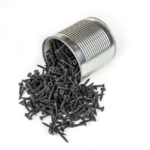Should I use drywall anchors? Hanging items on a wall built with drywall can be a puzzling task.
It’s easy to angle a nail into the wall with a few taps of the hammer and take your chances, but you know deep down that’s not the way it works.
Drywall is made from compressed gypsum, and can easily crack apart and crumble into dust.
Just how are you supposed to hoist up that giant framed photo of Big Sky and show it off for all to see? You need the right drywall anchor.
How to Use Drywall Anchors
There are amazing drywall anchor products available, some supporting hundreds of pounds on a single fastener.
- With a pencil, mark the point where you want your item to hang
- If required, drill a pilot hole
- Tap the anchor into place with a hammer, or install the self-drilling anchor into the wall
- Install the screw into the anchor and leave the screw head exposed as required for the item you are hanging
Choose your drywall fastener correctly, and with a few minutes of patient pre-work, you’ll have your walls supporting paintings, shelving, or pictures of almost any size or shape.

Which Drywall Anchors Should I Use?
With several drywall anchor options, which one is right for your project? Most of the time it will depend on the weight of the item you are hanging.
Under 10 Pounds – Plastic Sleeve Drywall Anchor
10 to 30 Pounds – Self-Drilling Drywall Anchor
30 to 50 Pounds – Toggle Bolt Anchor or Molly Bolt Anchor
Over 50 Pounds – SnapToggle Anchor or screws fastened directly into wood studs
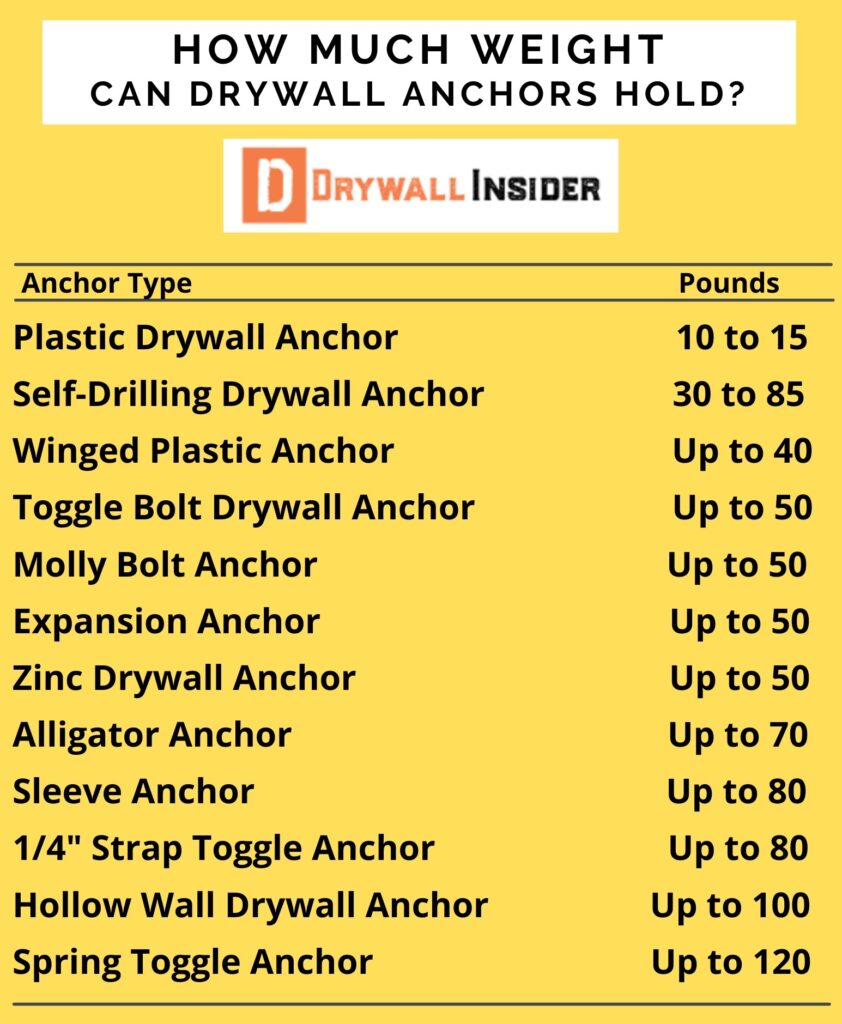
Self-Drilling Drywall Anchors
A self-drilling plastic anchor is possibly the easiest to install, but plastic models can break or snap while screwing into the wall.
Zinc-coated and zinc plated self-drilling anchors are much more durable and can support more weight, but costs more than plastic anchors.
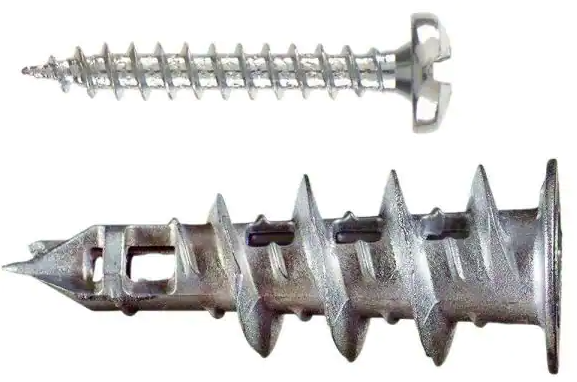
There are no pre-drilling holes with self-drilling anchors.
As long as you are careful not to hit a wall stud behind the drywall, self-drilling drywall anchors can be screwed directly into fresh drywall.
Use an electric drill for quick installation, but don’t over-drive the anchor in too fast.
The plastic self-tapping anchor will snap, or the threads will strip out the drywall needed to keep the anchor secure.
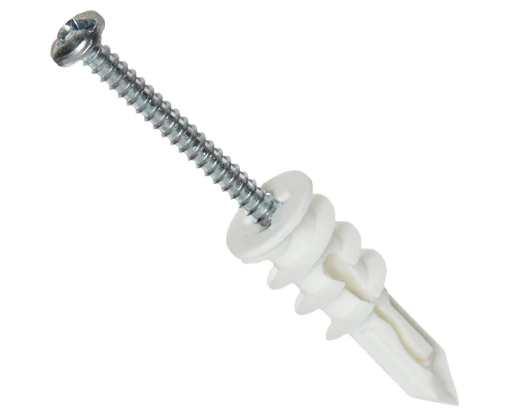
Leave the anchor flush with the wall, then add the small screw into the anchor. You’re ready to hang small shelves and picture frames in just minutes.
Toggle Bolts
When you need the strongest and sturdiest drywall anchors, most will recommend toggle bolts.
Also known as the “butterfly bolt” because of its wings that lock on the backside of the drywall as the bolt is toggled, or turned.
Installing a toggle anchor requires a drill and a drill bit the exact size of the anchor.
After the hole is drilled, push the folded anchor through the hole until the wings click through and spread open on the backside of the drywall.
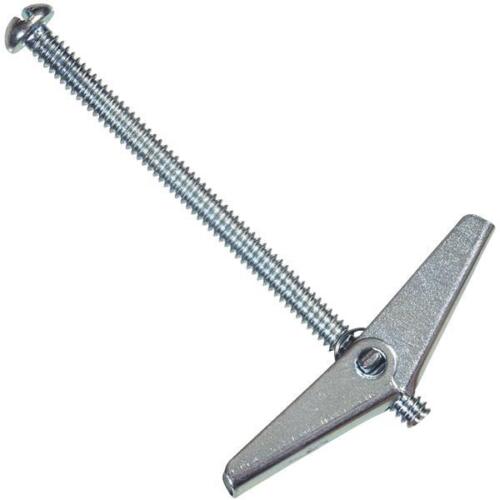
Toggle bolts are not the most affordable drywall anchors out there. The heaviest duty toggler can cost over a dollar each.
For example, the SnapToggle anchor is one of the strongest drywall anchors available and costs over $20 for a pack of 20.
But with an astounding 265-pound weight limit, the SnapToggle anchor is worthy of its price. Large pictures, mirrors, and even shelves can hang from the SnapToggle.
Hillman Strap Toggle – Another incredibly strong drywall anchor is the strap toggle, holding up to 265 pounds per anchor. For the biggest drywall anchor jobs, strap toggle hanging kits might be the best bet.
Anything from large picture frames to wall shelving can be hung from the Hillman Strap Toggle.
Usually, the Hillman Strap Toggle is sold with just one anchor per package.
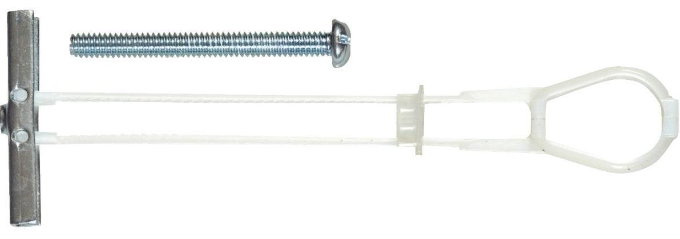
Hollow Wall Anchors
Carbon steel hollow wall anchors can be a great lightweight and medium-duty option for hanging items on drywall.
Hollow wall anchors include stainless steel screws inside the metal casing that expands as you tighten the screw. Most hollow wall anchors are made with rust-proof material and some are rated for vibration resistance.
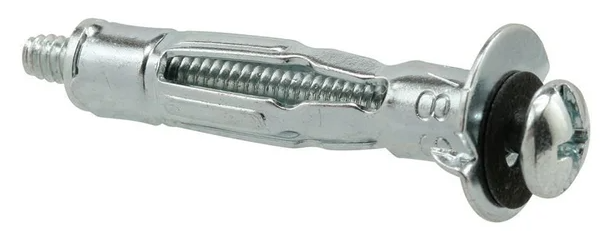
You can either pre-drill a hole or tap the hollow wall anchor straight into the drywall with a hammer. Some hollow wall metal anchors include washers for added strength.
Hollow wall anchors, also referred to as Molly bolts, are mostly for light-duty bathroom decor, coat hangers, or small shelves below a 100-pound weight limit.
Expansion Anchors
As expansion anchors are driven into drywall, the split ends expand creating a snug fit to the wall.
You will want to pre-drill a pilot hole that is slightly smaller than the anchor. Use a hammer to gently tap the anchor head flush with the wall surface.

As the pan-head Phillips screw is driven into the expansion anchor, the split ends of the shank expand. Depending on the size, expansion anchors can hold between 5 and 30 pounds.
Plastic expansion anchors are typically used for walls only, whereas other anchors are better suited for ceiling drywall.
Plastic anchors are sold in a few common sizes, depending on the size of the screw required for hanging.
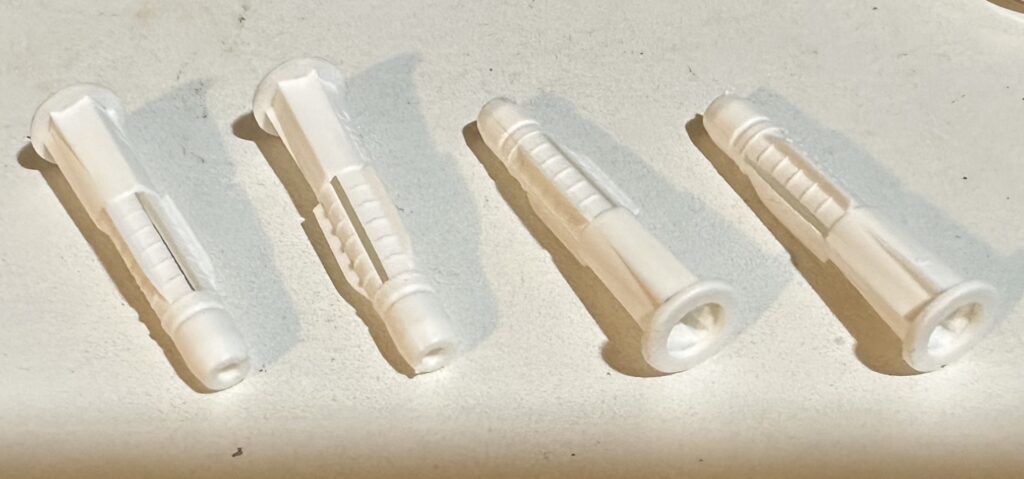
How to Remove Drywall Anchors
There are several ways to remove drywall anchors. Here’s a few tips:
Recess it, pull it out, cut it, or back it out. A few simple tools is all it takes.
- Recess the anchor – A screwdriver and a hammer can be the fastest and easiest way to remove a drywall anchor. Simply place the screwdriver on the anchor, and tap the anchor through the drywall with a few light hammer swings.
- Pull the anchor – If there’s a needle-nose pliers handy, oftentimes you can pull an unwanted anchor straight out of the wallboard. Slightly dig into the drywall on each side of the anchor and pull in a slow back-and-forth motion.
- Cut the anchor – If you’re dealing with an especially stubborn or heavy-duty drywall anchor, you might need a drill with a cutting wheel. Cut away the drywall around the head of the anchor and snip off the anchor head. Tap the remaining anchor through the drywall until it falls out behind the wall.
- Back out the anchor – Sometimes you can un-screw a drywall anchor and back it out, the same way it went in. Find a screwdriver that fits the anchor head and tap it snuggly with a hammer. Turn to the left, or counter-clockwise, and hopefully, the anchor will turn its way out of the wall.
How Much Weight Can Drywall Anchors Hold?
It really depends on the type of drywall anchor kit you are installing, so be sure to check specific product listings for weight limits and holding power.
Here’s a recap of the most common drywall anchor weight limits we discussed.
Self-Drilling Drywall Anchor – 30 to 85 pounds per fastener
Toggle Bolt Drywall Anchor – up to 50 pounds per fastener
Molly Bolt Anchor – up to 50 pounds per fastener
Plastic Drywall Anchor – 10 to 15 pounds per fastener
Hollow Wall Drywall Anchor – up to 100 pounds per fastener
Expansion Anchor – up to 50 pounds per fastener
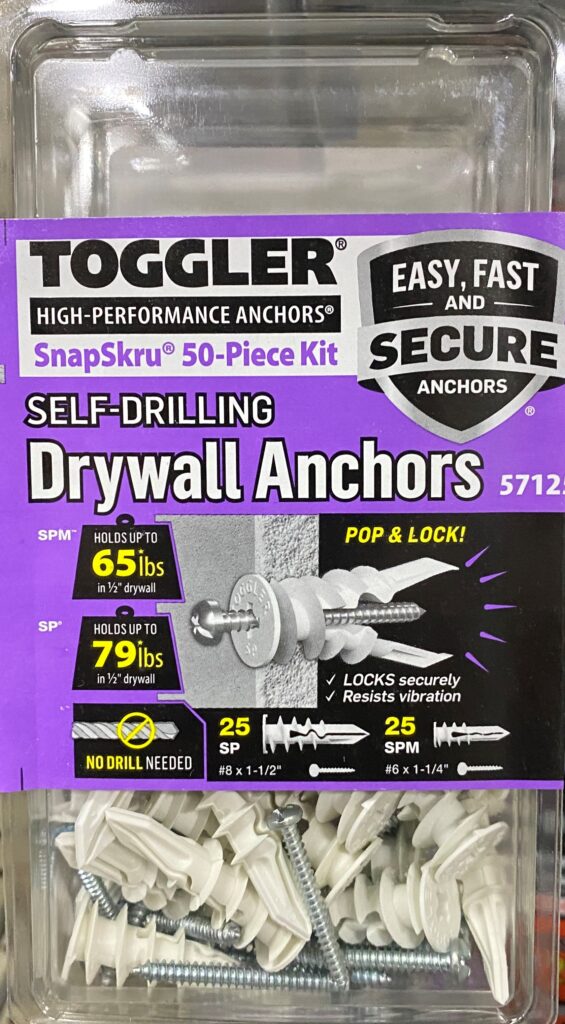
Do You Hammer or Screw in Drywall Anchors?
Again, it depends on the specific anchor you are installing. Follow proper install instructions on the packaging.
For example, a self-drilling anchor should be screwed into the wall, while an expansion anchor should be tapped into place after drilling a pilot hole.
Hillman, one of the most popular drywall anchor brands, prints details of their anchors on the front of each box.
You can find Hillman, and other popular brands of drywall anchors at major retailers such as Home Depot, Lowes, and of course on Amazon.
How to Use Drywall Anchors to Hang a Picture
SeeJaneDrill is a great home improvement and DIY YouTube Channel giving an in-depth tutorial on how to use drywall anchors to hang a picture.
She encourages all DIYers to dive-in, and figure it out on your own.
How Much Does Each Drywall Anchor Cost?
EZ Anchor for Drywall and Studs – $0.39 per Anchor
Toggler All Purpose Anchor – $0.43 per Anchor
Blue Hawk Toggle Bolts – $0.46 per Anchor
Toggler SnapSkru – $0.49 per Anchor
Hollow Wall Anchor – $0.84 per Anchor
EZ Toggle Cam – $1.24 per Anchor
Toggler Snaptoggle – $1.40 per Anchor


